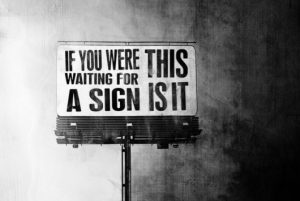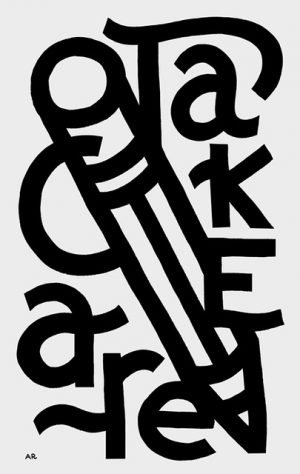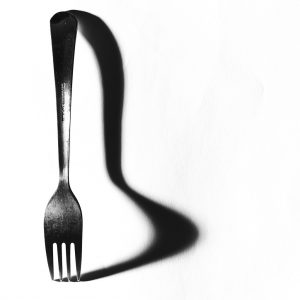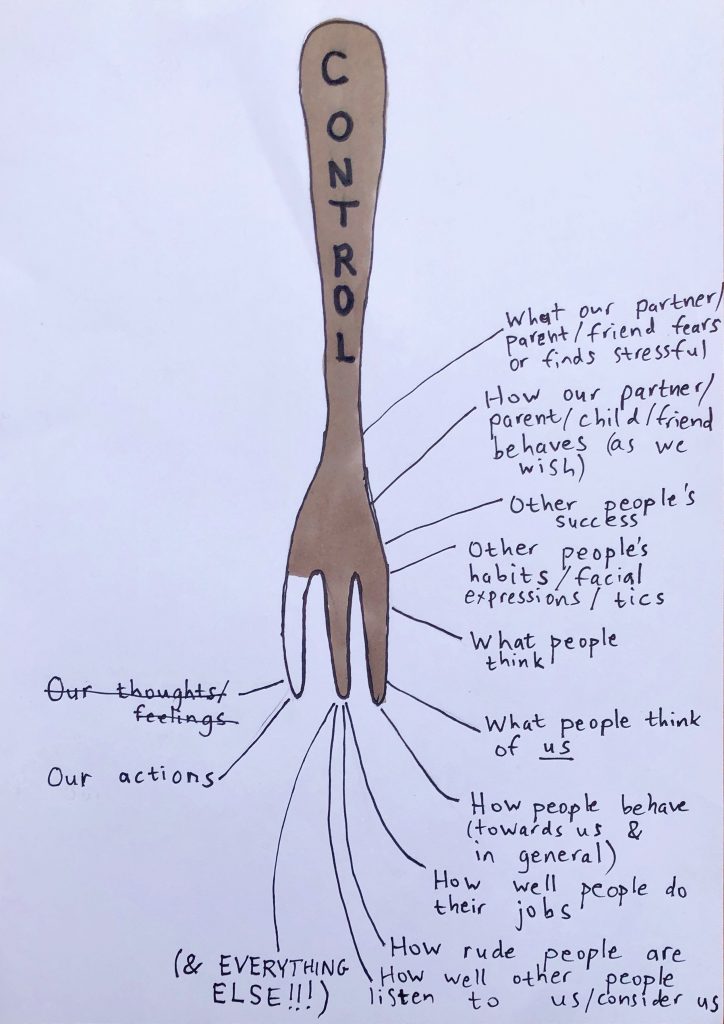 “…and here’s a secret for you – everything beautiful is sad…gilded with impermanence…”
“…and here’s a secret for you – everything beautiful is sad…gilded with impermanence…”
John Geddes
The Sufi tradition tells the story of a king who was surrounded by wise men. One morning, as they talked, the king was quieter than usual.
“What is wrong, Your Highness?” – asked one of the wise men.
“I’m confused,” replied the king. “At times I am overcome by melancholy, and feel powerless to fulfill my duties. At others, I am dizzy with all power I have. I’d like a talisman to help me be at peace with myself.”
The wise men – surprised by such a request – spent long months in discussion. In the end, they went to the king with a gift.
“We have engraved magic words on the talisman. Read them out loud whenever you are too confident, or very sad,” they said.
The king looked at the object he had ordered. It was a simple silver and gold ring, but with an inscription. Can you guess what was written on that silver and gold ring?
Sometimes, the most irritating thing we can hear from another person when we share our mental or physical distress with them is some variant on the intrinsic impermanence of all phenomena.
Although we all understand this concept philosophically, having it spelt out to us by another person can sometimes feel invalidating. As if to indicate that the genuine here-and-now feelings, body sensations, or thoughts I’m having are somehow illusory or inconsequential by dint of their transience. Sometimes with a client, but also with myself, I feel like the coach who shouts out to the boxer in the ring getting painfully pummelled: “Hang in there, Rocky! You may be having the stuffing knocked out of you now, but once you’re patched up and healed, you’ll be as good as new!”
It’s a different matter however when we bring this way of thinking to our own internal world with the hope of liberating us from some of the less helpful forms of suffering and entrapment that our language-facilitated psyches often land us with.
—
 The main way language traps us is by cementing, consolidating, and solidifying a mood, emotional state, thought, or body sensation. For example, while writing this, I notice that I am feeling tired and a little bit queasy. If I put this into words (“I’m feeling tired and a little bit queasy”), until I update that “reading” of my interoceptive environment, it acts like a dualistic off-on switch. What I mean by this is that my mind starts believing that I am either “tired” or “not tired”, “queasy” or “not queasy”. It loses all sense of gradation and perspective. As far as my mind is concerned, tired and queasy become the “last word” on my experience. That inner-reading, delivered through language should really come with a time and date stamp attached to it (“Hey Steve, two seconds ago you registered tired and queasy feelings in your body, but how about now?”), but it doesn’t. The mind gives us these readings as if they were timeless truths about ourselves and the world.
The main way language traps us is by cementing, consolidating, and solidifying a mood, emotional state, thought, or body sensation. For example, while writing this, I notice that I am feeling tired and a little bit queasy. If I put this into words (“I’m feeling tired and a little bit queasy”), until I update that “reading” of my interoceptive environment, it acts like a dualistic off-on switch. What I mean by this is that my mind starts believing that I am either “tired” or “not tired”, “queasy” or “not queasy”. It loses all sense of gradation and perspective. As far as my mind is concerned, tired and queasy become the “last word” on my experience. That inner-reading, delivered through language should really come with a time and date stamp attached to it (“Hey Steve, two seconds ago you registered tired and queasy feelings in your body, but how about now?”), but it doesn’t. The mind gives us these readings as if they were timeless truths about ourselves and the world.
When we get an email or text message from someone else however, we take into account the potential for change in that person between the act of committing a reading of their body sensations, thoughts, emotions to that written communication, and how they might be feeling now. Reading it a few hours later, we may recognise that this person could be in a different place altogether, either due to some form of self-care they embarked on (a nap, a walk, some peppermint tea), or just as a natural outcome of the fundamental impermanence of all phenomena, including tiredness and queasiness as bodily states.
Unfortunately, when the above reading gets served up by our minds, rather than a transient text message, it can sometimes appear in a way that a printed sign on a solid wooden post might catch our attention with its seemingly unarguable entreaty : “PATH HAZARDOUS DUE TO ICE – TAKE ALTERNATE ROUTE”.
The sign is maybe only appropriate for the day on which the suggestion was made, maybe even the month, or the whole winter of that year. But at some point, it will no longer act as a helpful indicator because the path will no longer be slippery and icy. And yet the sign doesn’t reflect when this happens, in the same way that our minds often fail to keep track of the moment-by-moment changes within us, noticing only significant peaks and troughs.
 My tiredness and queasiness, like all phenomena, is continually changing, even in the space of the time it took me to write this paragraph: sometimes strong, sometimes weak, sometimes noticeable and even oppressive, other times practically unnoticeable, negligible. But the mind, and language freezes or suspends these states in whatever reading was made at the point of noticing the sensation at first, and unless we factor into our reading the notion of impermanence, we might make a prison for ourselves of this thought, especially if the thing we’re focused on (thought, feeling, sensation) has some suffering attached to it.
My tiredness and queasiness, like all phenomena, is continually changing, even in the space of the time it took me to write this paragraph: sometimes strong, sometimes weak, sometimes noticeable and even oppressive, other times practically unnoticeable, negligible. But the mind, and language freezes or suspends these states in whatever reading was made at the point of noticing the sensation at first, and unless we factor into our reading the notion of impermanence, we might make a prison for ourselves of this thought, especially if the thing we’re focused on (thought, feeling, sensation) has some suffering attached to it.
GUILDENSTERN
Prison, my lord!
HAMLET
Denmark’s a prison.
ROSENCRANTZ
Then is the world one.
HAMLET
A goodly one; in which there are many confines,
wards and dungeons, Denmark being one o’ the worst.
ROSENCRANTZ
We think not so, my lord.
HAMLET
Why, then, ’tis none to you; for there is nothing
either good or bad, but thinking makes it so: to me
it is a prison.
We are all Hamlets in this regard. I get imprisoned by my thoughts a dozen times a day, how about you? Whenever I lose sight of the fact that thoughts are just thoughts, I’m cast into a bleak and airless cell. A kind of living death perhaps?
“To Taoism,” writes Alan Watts, “that which is absolutely still or absolutely perfect [i.e. rendered in language as a permanent fact] is absolutely dead. For without the possibility of growth and change there can be no Tao [i.e. the unconditional and unknowable source and guiding principle of all reality]. For there is nothing in the universe which is completely perfect or completely still; it is only in our minds that such concepts exist.”
I think when we take this on board in an experiential, “lived” way, this impermanence, this ever-changing, fluctuating nature of all phenomena inside us and outside us, can be incredibly liberating.
Let’s say someone you were counting on lets you down? Or it could be an experience you enjoyed the last time you had it, but not this time. Of course we’re disappointed. But if every phenomenon in our experience, material and immaterial, is fundamentally inconstant, impermanent, transient, why are we holding out for our fool’s paradise?
Well, that goes without saying: because the illusion of permanence and stability feels safer and more comforting. But it can also be devitalizing, ensnaring, and rife with suffering.
—
 Maybe it would be good, like the king in the Sufi fable, to have a magic spell of sorts, a talisman, something that unhooks or unchains us from the inflexibility of our own, and others’ linguistic formulations, returning us to the light-and-shade flux of our lived experience?
Maybe it would be good, like the king in the Sufi fable, to have a magic spell of sorts, a talisman, something that unhooks or unchains us from the inflexibility of our own, and others’ linguistic formulations, returning us to the light-and-shade flux of our lived experience?
Sometimes it might be enough to just use this reflection of transience in something like a this-too-shall pass mantra. Or if those words have lost their power by becoming over-memified and commodified (another good example of this: keep calm, and carry on) we may need to recite a small poem or prayer, like this verse recited at buddhist funerals, but also by monastics on a daily basis:
All things are impermanent.
They arise and then they pass away.
Having arisen they come to an end.
May we find peace by remembering this.
I also like these doleful lines from Dogen:
Your body is like a dew-drop on the morning grass,
your life is as brief as a flash of lightning.
Momentary and vain, it is lost in a moment.
I find it interesting that Siddhartha’s last words according to the Mahāparinibbāna sutra are reported to be a variant of this teaching: “”Disciples, I tell you this: All conditioned things are subject to disintegration – strive on untiringly for your liberation.” This is not an encouragement to withdraw to a timeless, mystical now, but rather, as Stephen Batchelor explains “an unflinching encounter with the contingent world as it unravels moment to moment” and so “embark on a new relationship with the impermanence and temporality of life.”
In our Western tradition, we find a very similar message in Pyrrho’s Aristocles Passage. Wise men and women in all our recorded culture have focused on impermanence as being a very important door through which we need to pass to find peace in ourselves and the world. If we can only, even for a moment, take on the fact of our own impermanent sojourn in the timeframe of this one life allotted to us, take this on viscerally, as a lived experience, rather than as an idea (“Death whispers in my ear,” Virgil reminds us, “Live now, for I am coming.”) then who knows what kind of living we might be able to squeeze out of the lives we’ve won in the sperm-egg lottery.
The poet Ron Padgett comes at this truth from a Christian perspective in his poem The Joke:
THE JOKE
When Jesus found himself
nailed to the cross,
crushed with despair,
crying out
“Why hast thou forsaken me?”
he enacted the story
of every person who suddenly realizes
not that he or she has been forsaken
but that there never was
a forsaker,
for the idea of immortality
that is the birthright of every human being
gradually vanishes
until it is gone
and we cry out.
Sometimes though, this self-imposed reflection isn’t enough, and we might need to do some more intensive defusing and unhooking.
—

Here are a couple of visualisations to play around with, using fairground rides to help us unhook from impermanent/conditional thoughts-emotions-sensations that entrap us through language, language rendering them as unconditional, immutable and imperishable. Don’t feel you have to do them exactly as I’ve envisaged. Once you’ve got the idea, make one of them work in a way that suits your imagination.
1/ This Too Shall Pass as a MERRY-GO-ROUND:
 On the merry-go-round of the mind there is a problem with speed as much as anything else: the whirring thoughts and feelings, the jarring, jangling music. So first of all, cut the power switch the merry go round off for a moment. Stop it. Imagine all the lights expunged, the music silenced, the painted wooden horses in shadow.
On the merry-go-round of the mind there is a problem with speed as much as anything else: the whirring thoughts and feelings, the jarring, jangling music. So first of all, cut the power switch the merry go round off for a moment. Stop it. Imagine all the lights expunged, the music silenced, the painted wooden horses in shadow.
Now walk around it and see if you can find the one that’s tormenting you. It might be horse-shaped, or it might look like something else. See if it can reveal itself to you.
When you find it, notice it’s colour, shape, texture, how large or small it is. Notice where you might position yourself on it or next to it if you were to go on this ride.
Now deliberately imagine yourself stepping off the platform.
Find a place a good 10 or 15 metres away where you can still see the merry-go-round or carousel, but it doesn’t take up your whole view. Notice what else is there in the park, see if maybe there’s a ride you might even want to go on.
Take a few deep breaths and get your bearings.
When you’re ready, throw the switch and let the carousel begin to spin again, you may even imagine it spinning really fast so that it becomes a kind of spinning top and takes off into space.
Or you may start feeling queasy just at the spin on it right now, and so after glimpsing your bugbear every few seconds whirling around and around and around. See if you can watch it until you start to feel a little bored with the sight, and are ready for a refreshment or some other distraction.
2/ This Too Shall Pass as a FERRIS WHEEL:
 Again, see if you can identify your bundle of feelings and thoughts that have got you “locked into” the seat or cage of the ferris wheel: “Oh, there’s shame, and hurt, and frustration. Oh there’s why-can’t-they-respond-as-I-wish-them-too?” etc.
Again, see if you can identify your bundle of feelings and thoughts that have got you “locked into” the seat or cage of the ferris wheel: “Oh, there’s shame, and hurt, and frustration. Oh there’s why-can’t-they-respond-as-I-wish-them-too?” etc.
Get a sense of how fast the wheel is turning. It may be moving very, v…e…r…y slowly. You may want to join yourself for a moment on the ride and let your shamed/hurt/frustrated self hear some words it needs to hear from a more soothing, reassuring part of you.
Breathe. See if you can surrender to the pod, or seat, something that symbolises your upset: a photograph, a screenshot of a text message, an object.
Then claiming your hurt and upset self, perhaps holding its hand the way you might a scared or sad child or small animal, watch as the wheel begins to inch its way upwards and the pain inside “your” seat or pod, like everyone else’s pain in their seats, begins to “pass”.
Not disappearing but slowly, maybe v…e…r…y slowly increasing its distance between you and this thought-feeling-situation bundled up as a vexing hurt.
When the wheel reaches its apex, a hundred metres up or more, invite a bird or some other winged creature to fly into the pod and take the item you’ve left there away with it.
Imagine what the bird might do with this object. Perhaps line its nest, or bury it, or eat it (birds like text messages and photographs, they feed off them like sunflower seeds). Maybe even imagine the item passing through the bird’s intestines, this hurt of yours transformed into excrement and eradicated over trees and hills and fields full of wheat ready for harvest.
3) This Too Shall Pass as a BUS, TUBE, TRAIN or AIRPLANE:
 Unlike merry-go-rounds and ferris wheels, tubes and trains usually have destinations associated with them. Consider where the cluster of thoughts and feelings and sensations you are currently experiencing may lead if you hop on the bus, or train, or plane and fly with them. Maybe even imagine that destination written on the front of the train or the plane.
Unlike merry-go-rounds and ferris wheels, tubes and trains usually have destinations associated with them. Consider where the cluster of thoughts and feelings and sensations you are currently experiencing may lead if you hop on the bus, or train, or plane and fly with them. Maybe even imagine that destination written on the front of the train or the plane.
Perhaps today’s train is destined for a place of ABANDONMENT or NON-RECIPROCATION (either receiving or giving). Often the destination, the final stop on the line is one of too-much or too-little.
Too much of a certain type of interaction with another human animal, or our environment, and thus a feeling of overwhelm, or too little which then results in a feeling of deprivation, a foresaken emptiness, loneliness and alienation.
Take a moment to consider whether you want to ride this train all the way to its final stop. If not, especially if you’ve made this journey before and found it a fruitless one, you may decide to let the train pull into the station, load it up with all your hurt thoughts and feelings, and then let it depart.
Watch it go, check the platform, are there still thoughts and feelings amassing in quantities that threaten to arrest your next meaningful action? You may have to stay on the platform and let those passengers fill the carriage of the next train into the station.
Identify each one as they climb aboard, like Noah counting and tagging every creature that climbed aboard the ark. “OK, here’s a thought that [this person/situation] is X. Here the feeling of […] again. Here’s the desire to do x, y, z, which probably wouldn’t help matters but…” Repeat until the platform has a bunch of hangers-on who don’t want to pass, don’t want to go. Let them if need be accompany you as you step away from the platform and focus on something meaningful and interesting calling for your attention.
—
 Thanks for reading. Oh, and if you’re struggling with thoughts, feelings, body sensations, or situations that seem to your mind particularly oppressive and imprisoning, other than some of the suggestions presented above, you might also want to consider learning by heart one of these poems and reciting it as a more extended mantra when feeling trapped. That’s something I do, and I find it helps.
Thanks for reading. Oh, and if you’re struggling with thoughts, feelings, body sensations, or situations that seem to your mind particularly oppressive and imprisoning, other than some of the suggestions presented above, you might also want to consider learning by heart one of these poems and reciting it as a more extended mantra when feeling trapped. That’s something I do, and I find it helps.

 At the moment, I wake up to jackhammers and drills.
At the moment, I wake up to jackhammers and drills.  We need to skilfully differentiate between what is in our power and what is not. And that very differentiation happens to be the first thing we read about in a book of collected discourses issuing from the lips and the mind of a crippled, Roman slave named Epictetus who lived 2000 years ago. I like to imagine him as a slightly more philosophical and Latin-spouting version of
We need to skilfully differentiate between what is in our power and what is not. And that very differentiation happens to be the first thing we read about in a book of collected discourses issuing from the lips and the mind of a crippled, Roman slave named Epictetus who lived 2000 years ago. I like to imagine him as a slightly more philosophical and Latin-spouting version of 

 As soon as Charlie sits down, I can tell that he’s feeling a little bit “off” today.
As soon as Charlie sits down, I can tell that he’s feeling a little bit “off” today.